Europeanisation, National Identities and Migration ... - europeanization
Europeanisation, National Identities and Migration ... - europeanization
Europeanisation, National Identities and Migration ... - europeanization
Create successful ePaper yourself
Turn your PDF publications into a flip-book with our unique Google optimized e-Paper software.
214 Norbert Cyrus<br />
increasing xenophobia among our workers’ (IG BSE o. J., quoted in Treichler 1998:<br />
224). To extinguish xenophobic attitudes among its members, IG BAU proposed<br />
restricting access to German labour markets. The logic behind this argument is as<br />
follows: ‘xenophobic anxieties about immigrants serve to justify a policy of restricting<br />
migration, <strong>and</strong> that policy is then expected to preserve the population from antiforeigner<br />
ideologies’ (Blaschke 1998: 25).<br />
The more important aspect here is that IG BAU, in order to achieve its<br />
organisational goals, exploits not only the stereotype of foreign workers but also of<br />
its own members. The stereotype of a ‘racist German construction worker’ was<br />
accepted <strong>and</strong> used as an argument in order to strengthen its own position. IG BAU<br />
used the argument of xenophobia as a threatening means. The point of interest<br />
according to Treichler (1998: 224) is that xenophobia was discovered as a matter<br />
of fact by the organisation only in a situation when the competition with foreign<br />
workers from Pol<strong>and</strong> <strong>and</strong> other CEE-countries raised the threat that domestic<br />
workers would be replaced. Xenophobia was however not the subject of intraorganisational<br />
dispute, but was<br />
politically used by the sectoral trade union as a threatening factor in order to<br />
mobilise against the inter-governmental agreements. To give one example, the<br />
deputy chairman of IG BAU, Ernst Ludwig Laux, mentioned with regard to<br />
the impact of the contract agreements with CEE countries on the German<br />
construction labour market in September 1992: ‘Whoever adds fuel to the fire<br />
with such approaches (i.e. the intergovernmental agreements) <strong>and</strong> undermines<br />
the tariff order will in due course be surprised by the echo’.<br />
(Treichler 1998: 225)<br />
This argument was repeated with respect to the contract workers <strong>and</strong> the European<br />
posted workers as well (Sahl 1997). The organisation portrays its members as<br />
susceptible to or even affected by xenophobia, <strong>and</strong> itself as an organisation trying<br />
to pacify them. But Faist et al. in their study (1999) reject the claim that xenophobia<br />
is a characteristic of construction workers:<br />
According to all information available, Polish contract workers explained<br />
that they have no problems with German colleagues, however they often<br />
criticised the degrading attitude of employees of German-controlled authorities<br />
against foreigners. However, in the course of the deterioration of the labour<br />
market situation in the construction sector, most of all in developments since<br />
the mid-1990s, activities could be observed that increasingly raised the media<br />
interest: bigger construction sites with a high share of foreign workers from<br />
the so-called cheap paid countries were occupied or blockaded by German<br />
workers. The impetus for such actions may have come from the increasing<br />
political visibility of the subject – with xenophobia running along – by trade<br />
unions <strong>and</strong> sectoral employers’ associations, who had pointed to the high<br />
amount of employment of foreigners.<br />
(Faist et al. 1999: 221)



